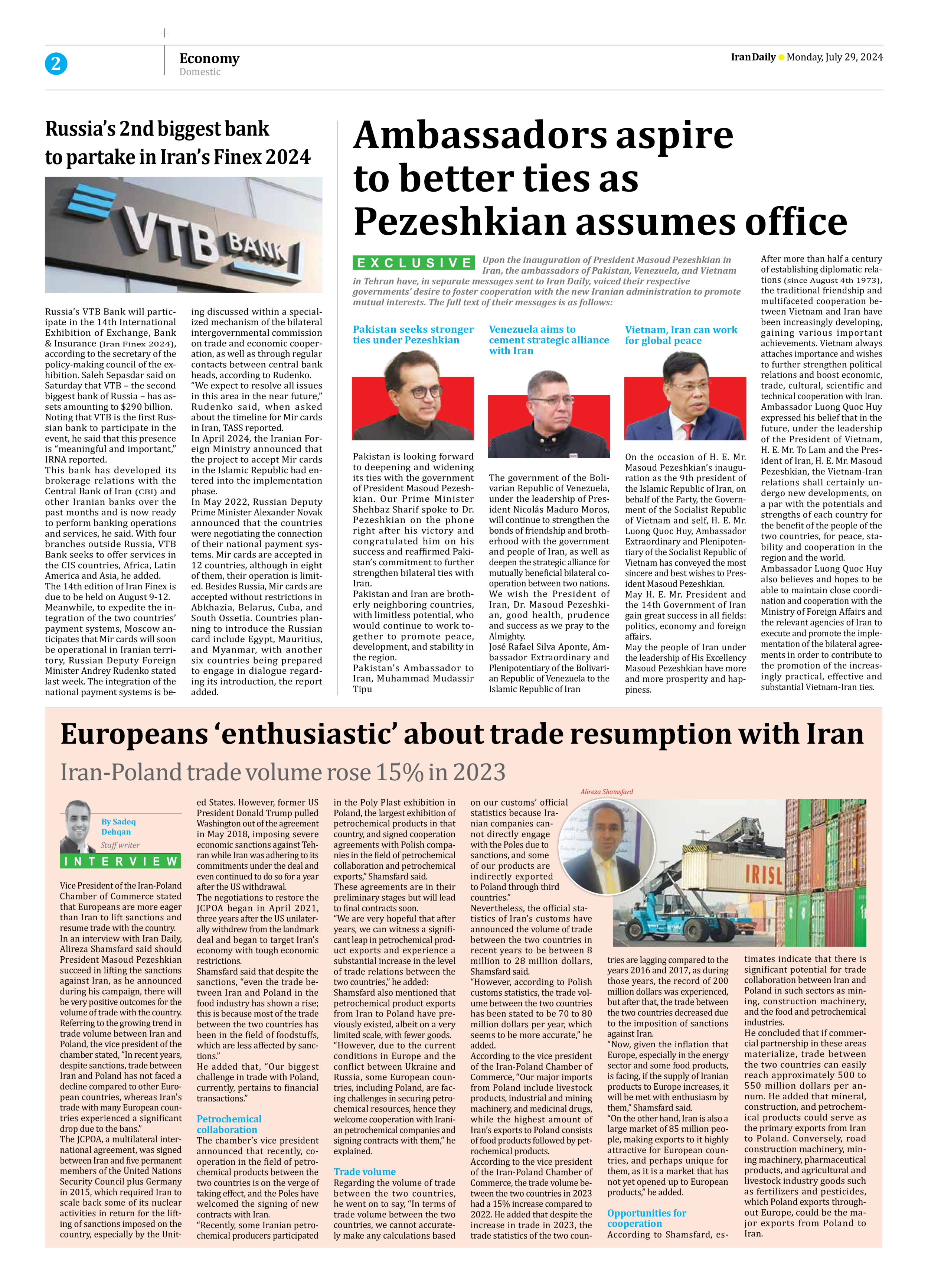
Europeans ‘enthusiastic’ about trade resumption with Iran
Iran-Poland trade volume rose 15% in 2023
By Sadeq
Dehqan
Staff writer
Vice President of the Iran-Poland Chamber of Commerce stated that Europeans are more eager than Iran to lift sanctions and resume trade with the country.
In an interview with Iran Daily, Alireza Shamsfard said should President Masoud Pezeshkian succeed in lifting the sanctions against Iran, as he announced during his campaign, there will be very positive outcomes for the volume of trade with the country.
Referring to the growing trend in trade volume between Iran and Poland, the vice president of the chamber stated, “In recent years, despite sanctions, trade between Iran and Poland has not faced a decline compared to other European countries, whereas Iran’s trade with many European countries experienced a significant drop due to the bans.”
The JCPOA, a multilateral international agreement, was signed between Iran and five permanent members of the United Nations Security Council plus Germany in 2015, which required Iran to scale back some of its nuclear activities in return for the lifting of sanctions imposed on the country, especially by the United States. However, former US President Donald Trump pulled Washington out of the agreement in May 2018, imposing severe economic sanctions against Tehran while Iran was adhering to its commitments under the deal and even continued to do so for a year after the US withdrawal.
The negotiations to restore the JCPOA began in April 2021, three years after the US unilaterally withdrew from the landmark deal and began to target Iran’s economy with tough economic restrictions.
Shamsfard said that despite the sanctions, “even the trade between Iran and Poland in the food industry has shown a rise; this is because most of the trade between the two countries has been in the field of foodstuffs, which are less affected by sanctions.”
He added that, “Our biggest challenge in trade with Poland, currently, pertains to financial transactions.”
Petrochemical
collaboration
The chamber’s vice president announced that recently, cooperation in the field of petrochemical products between the two countries is on the verge of taking effect, and the Poles have welcomed the signing of new contracts with Iran.
“Recently, some Iranian petrochemical producers participated in the Poly Plast exhibition in Poland, the largest exhibition of petrochemical products in that country, and signed cooperation agreements with Polish companies in the field of petrochemical collaboration and petrochemical exports,” Shamsfard said.
These agreements are in their preliminary stages but will lead to final contracts soon.
“We are very hopeful that after years, we can witness a significant leap in petrochemical product exports and experience a substantial increase in the level of trade relations between the two countries,” he added:
Shamsfard also mentioned that petrochemical product exports from Iran to Poland have previously existed, albeit on a very limited scale, with fewer goods.
“However, due to the current conditions in Europe and the conflict between Ukraine and Russia, some European countries, including Poland, are facing challenges in securing petrochemical resources, hence they welcome cooperation with Iranian petrochemical companies and signing contracts with them,” he explained.
Trade volume
Regarding the volume of trade between the two countries, he went on to say, “In terms of trade volume between the two countries, we cannot accurately make any calculations based on our customs’ official statistics because Iranian companies cannot directly engage with the Poles due to sanctions, and some of our products are indirectly exported to Poland through third countries.”
Nevertheless, the official statistics of Iran’s customs have announced the volume of trade between the two countries in recent years to be between 8 million to 28 million dollars, Shamsfard said.
“However, according to Polish customs statistics, the trade volume between the two countries has been stated to be 70 to 80 million dollars per year, which seems to be more accurate,” he added.
According to the vice president of the Iran-Poland Chamber of Commerce, “Our major imports from Poland include livestock products, industrial and mining machinery, and medicinal drugs, while the highest amount of Iran’s exports to Poland consists of food products followed by petrochemical products.
According to the vice president of the Iran-Poland Chamber of Commerce, the trade volume between the two countries in 2023 had a 15% increase compared to 2022. He added that despite the increase in trade in 2023, the trade statistics of the two countries are lagging compared to the years 2016 and 2017, as during those years, the record of 200 million dollars was experienced, but after that, the trade between the two countries decreased due to the imposition of sanctions against Iran.
“Now, given the inflation that Europe, especially in the energy sector and some food products, is facing, if the supply of Iranian products to Europe increases, it will be met with enthusiasm by them,” Shamsfard said.
“On the other hand, Iran is also a large market of 85 million people, making exports to it highly attractive for European countries, and perhaps unique for them, as it is a market that has not yet opened up to European products,” he added.
Opportunities for
cooperation
According to Shamsfard, estimates indicate that there is significant potential for trade collaboration between Iran and Poland in such sectors as mining, construction machinery, and the food and petrochemical industries.
He concluded that if commercial partnership in these areas materialize, trade between the two countries can easily reach approximately 500 to 550 million dollars per annum. He added that mineral, construction, and petrochemical products could serve as the primary exports from Iran to Poland. Conversely, road construction machinery, mining machinery, pharmaceutical products, and agricultural and livestock industry goods such as fertilizers and pesticides, which Poland exports throughout Europe, could be the major exports from Poland to
Iran.







